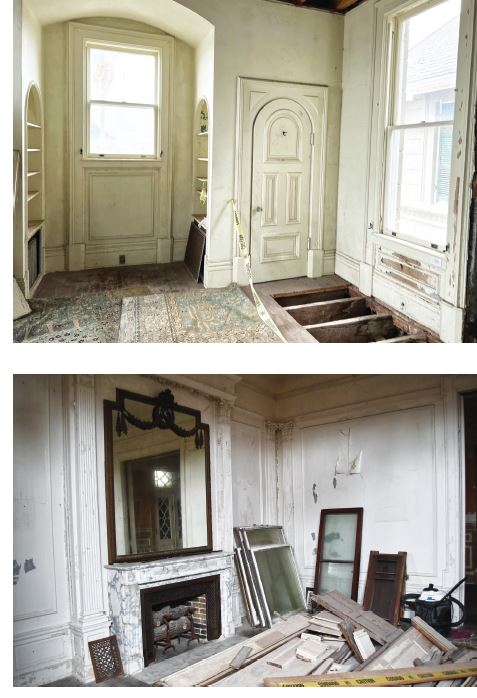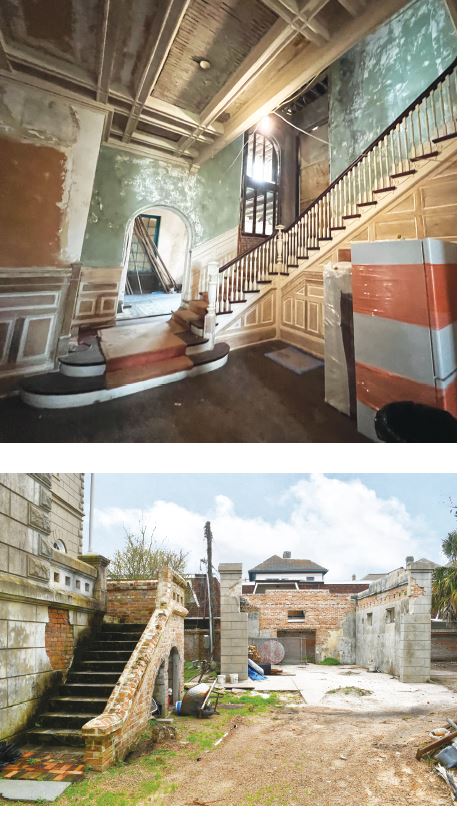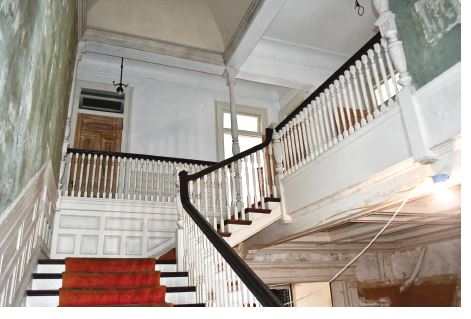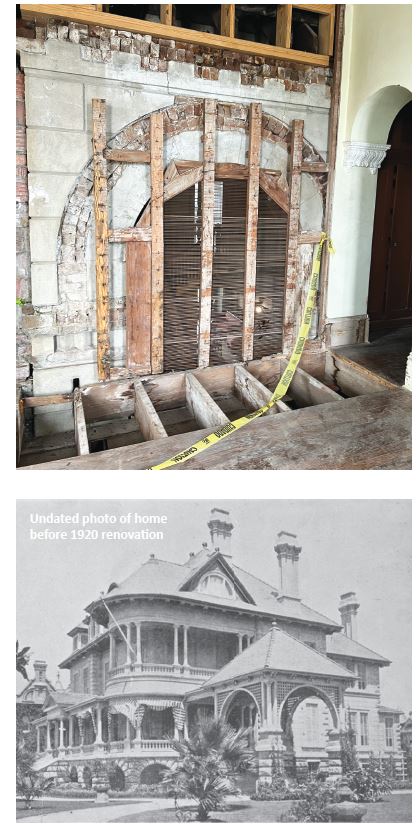Commanding the one-acre corner lot at 1702 Broadway, the 1893 League Kempner Home is the last grand home designed by Nicholas Clayton for the Broadway Castle District. The pre-eminent architect conceived the design for John Charles League and his wife Nellie Ball, a power couple who represented the joining of two of Galveston’s most prominent families.
Janie Mitcham, owner of the 1887 Lucas Terrace Apartments, purchased the property two years ago with the intent to save it for future generations. It is now set up as a nonprofit.
For eight years Mitcham drove by the home and was troubled with its decent into decay.
“The thing that attracted me was a window that was open in this little alcove on the side, and it was never closed,” Mitcham said. “I was going back and forth working on the Lucas, and there were extension cords running from window to window on the outside, and it was just looking worse and worse and worse.”
One day, on their way to eat seafood, she noticed a for sale sign in the yard. She and her husband pulled over, went inside and made an offer to buy it.
Their offer was accepted on Christmas morning, and the purchase was completed in January 2021.
The massive restoration of the property has begun, but it will be a tedious process to restore the former glory of the mansion and grounds.
The three-story, slate roofed, gray-stuccoed brick structure with wrap around front and side porches rests atop a stone elevation basement with arched windows. Windows are punctuated with green louvered blinds that can be opened and closed with small hand cranks in the interior.
 A circle driveway at the side of the home leads through a porte-cochere, with steps leading upward to the porch, where guests could enter through walk-through windows. A closer look at the side of the steps reveals signs of the grade raising after the 1900 Storm as they seem to sink into the ground.
A circle driveway at the side of the home leads through a porte-cochere, with steps leading upward to the porch, where guests could enter through walk-through windows. A closer look at the side of the steps reveals signs of the grade raising after the 1900 Storm as they seem to sink into the ground.
“It’s probably another 18 inches down from what is ground level now to the original first step,” explains Mitcham as she points out the soil line. “There are probably another two steps to be uncovered.”
Turning to face a low, stone planter she adds, “I have a picture of Daisy (League) standing here by the planter. It’s one of the few vintage pictures we have outside of the house. We’ll rebuild this to look like it did originally.”
League was one of the earliest owners of automobiles on the island, necessitating the covered drive along with a one-story brick garage and a tool house at the back of the property.
The front of the lot is surrounded by an antique wrought iron fence, while the back gardens are shielded with a concrete wall. Now quite bare, the grounds were once home to one of the most coveted gardens in Galveston.
After finding the support of the porch had failed, Mitcham’s team demolished the arched structures beneath it. “Masons built a form to build back the arches that will be re-stuccoed when complete. The porch still has problems like the steel I-beam supports that are basically railroad ties. They’re so rusted there is nothing in the wall anymore, so we built a temporary structure of arched brick.”
It's just one example of numerous concurrent projects to stabilize the overall structure of the home.
In its heyday, guests entered the home through imposing double front doors and crossed a tiled vestibule, which is still in place. Mitcham surmises that the Kempner family, second owners of the mansion, replaced the original leaded glass doors with the current doors in the 1920s, and stained the original oak a darker color in line with the popular Asian esthetic of the era.
Visitors would most likely have been ushered into the parlor or music room to the left, which is anchored with a large marble surround fireplace beneath a pier mirror. Though many of the home’s original items were sold in a large estate sale, this pier mirror remains, probably due to its secure installation.
“The fireplaces were always gas, so the chimneys are all decorative because they have little bitty pipes. We even have the original gas logs, which is great.”
League’s personal study across the grand hallway to the right features two walls of built-in bookshelves, its own fireplace, and pocket doors for privacy.
Standing between these two rooms and looking toward the back of the house, visitors were originally greeted with possibly the most stunning staircase on an island known for its grand architecture, flanked on two sides and canopied from above with immense Tiffany-style windows. A large cupola provides light to the ceiling window.
“Can you imagine being on that stairway?” sighs Mitcham. “And the windows are fabulous, but they aren’t there right now. They’re at a restoration company in Waco. They’re in fragile shape, so I wanted them out before we started taking ladders and things up and down the stairs.”
The windows were made with Tiffany glass by the J&R Lamb Studios, America’s oldest continuously run decorative arts company. The walls surrounding the windows are the location of some of the most extreme water damage due to roof leaks and improper gutter installation.
“I'm going say when all is said and done, and I change my estimate daily, but it's going be about $400,000 worth of repair because of that leak. The windows alone are about $120,000 to restore. And that's not counting building the frames and the foundational work,” she said. “But we're so fortunate that every staircase spindle is here.”
The battle against termites, water leaks, and rot required Mitcham’s team to cut holes in floors to replace joists, and brace structures. They found two or three places that had signs of small electrical fires.
There are also areas where floor joists were actually cut through during previous renovations, causing areas to “free float” with no support. Mitcham credits the original construction for the fact the building is still standing.
 “It didn’t move because everything is so well made. The decking on the roof, for instance, is tongue and groove, so it’s joined together and nailed together.”
“It didn’t move because everything is so well made. The decking on the roof, for instance, is tongue and groove, so it’s joined together and nailed together.”
The owner plans to leave a few areas that show the history of the house’s evolution and its construction visible for visitors by covering them with plexiglass.
The dining room to the right of the stairs was designed with its own built-ins and fireplace, and a walk-through butler’s pantry leading to the kitchen which has never been updated, to the delight of Mitcham. From there one can access the servants’ stairs which lead to all three floors, unlike the formal stair that only lead only to the second story.
The house has original wood floors, which tell another part of the home’s history. While removing flooring in the dining room, Mitcham discovered what appeared to be three floors.
“The original League floor was a typical Victorian, when they used large area rugs on the floor. Since it would be covered, a lower grade pine was used and stained around the edge. I’m sure that Eliza (Kempner) came in and said ‘Well that’s ugly,’ and put an overlay on it.”
The floors that did not have rugs, such as the hallway, had a higher quality wood. Upstairs utilized a lower cost wood as well, which is still a higher quality than most wood floors today.
“So they put their money downstairs where it would show.”
The original dumb waiter was replaced with an Otis elevator in the 1930s, which is no longer functioning; the formerly fanciful car sits motionless in the basement.
A second floor servant’s bedroom features a small built-in closet and an electric service bell, so the homeowners could call downstairs when needed.
Beside the bedroom is a workroom with a large sink with an extra-large drain that was called a “slophopper” in Clayton’s house plans, that would have been used to empty bedpans, or wring mops.
“The servants’ stairs are the only ones that go to the third floor where their workspace is. The grand staircase only goes to the second floor.”
In addition to a work area, the third floor has a built-in closet for seasonal clothing storage, a cistern with an electric pump that provided pressurized water, a bathroom and access to the cupola, which incorporates hand-forged ironwork.
 Explaining that the cupola’s primary purpose was for ventilation in the days before air-conditioning, Mitcham elaborates that the small block designs around the dome above the main stairs are “actually open holes that lead to the cupola. In the summer, you could open it up to let the hot air rise out of the home, and, in the winter, close them to try to keep the warm air in.”
Explaining that the cupola’s primary purpose was for ventilation in the days before air-conditioning, Mitcham elaborates that the small block designs around the dome above the main stairs are “actually open holes that lead to the cupola. In the summer, you could open it up to let the hot air rise out of the home, and, in the winter, close them to try to keep the warm air in.”
The third floor windows offer stunning views of the island.
Chauffeurs’ quarters were in the basement, as well as a laundry room, and a servants’ bathroom. Each had a concrete floor, bead board walls, and tongue-in-groove pine ceiling.
Insurance records for the property reveal that the home once incorporated both gas and electricity, ten rooms, five halls, 13 closets, three porches, six fireplaces, and two greenhouses.
 Eliza Kempner purchased the home in 1919 from Mrs. League for $20,000, and it remained in that family until 1972.
Eliza Kempner purchased the home in 1919 from Mrs. League for $20,000, and it remained in that family until 1972.
One of the original porches, a curved bay on the second floor, was enclosed during 1920 renovations by Houston architect Birdsall Briscoe (1876-1971) and now has the appearance of a turret. A garden room was added at the back of the house during the same period.
Expanded over time and a series of owners, the grand house now has nearly 8,000 square feet of living space, seven large bedrooms, five full baths, and two half baths.
Mitcham is enchanted with some of her unexpected finds in the house, including original tile in the kitchen and bathrooms, original wall phone and earpiece, original doors stored in the basement, portions of original wallpaper, tile featuring daisies surrounding Daisy’s bedroom fireplace, and even an 1893 toilet from the servants’ room.
One greenhouse, most likely purchased by Eliza Kempner, remains on the grounds. Entirely overgrown with grapevine and weeds when Mitcham took possession of the property, the grounds are now cleared and ready to be restored.
In 1962, the League Kempner Home was approved by the Texas State Historical Survey Committee for a Texas Historic Medallion. Despite retaining that honor, years of neglect earned the home a place on Galveston Historical Foundations Heritage At Risk List.
“The cool thing about the house is it's almost all original. Even though Eliza Kempner added onto it, they didn't move walls or move doors or do anything drastic.”
Mitcham shares that though she knew it was an immense undertaking, the damage caused by age, water, and termites has been extensive.
“It has a massive Formosan termite infestation, which is rampant on the island and very problematic. The water doesn't help that. I had crews here the morning we closed trying to get it dry - at least some of the big leaks in the roof - and then start in the basement on the foundation.”
After two years of stabilizing the structure and working on the basement, the team is looking forward to beginning the job of updating the plumbing and electrical system.
“People want to know what we've been doing, and I would say 95 percent of it will never show because it will all get plastered over. Everything gets organized on the critical path by what's most important to maintaining the structure.”
She projects that the project could take three- to five years to complete properly - and with respect to the history of the home.
“There's no one way to do most things. It's a matter of weighing all the options and impacts. A lot of people have commented that they could do it faster, but it takes a year of crawling around the property to really understand it.”
The property is now a nonprofit and the process of restoring the home is being featured on a YouTube channel as a way to earn revenues by the number of views the videos receive. So far, Mitcham shares that it has earned about $1,000.
“We’re hoping to get that up to about $6,000 a year. We’d like to have that revenue eventually cover the cost of insurance.”
“We can just slowly schedule work as we have funds raised from events, tours, or anything.”
She has plans to offer the gardens as an event venue but will have to complete bathrooms and landscaping first.
The progress and discoveries made during the 1893 League Kempner Home renovation can be watched on YouTube or Instagram at @leaguekempnerhouse, or through their website at leaguekempnerhouse.org, where interested parties can also make a donation or volunteer their time to help.